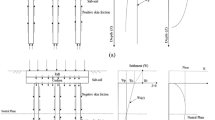Abstract
Several cases of instability of cut slopes along major highways in Jordan were reviewed in this study, in some detail. Emphasis was placed on the Amman-Irbid highway, but some cases along the Na'ur-Dead Sea highway were also reviewed, with the aim of establishing a wider database of case-studies and examining all possible mechanisms and factors influencing stability. The study showed that major cut slope failures were caused by the presence of weak cohesive layers (mainly clayey marl) interbedded within mostly stronger formations, in addition to the steep cutting angles and unfavorable dip of strata combined with relatively high piezometric surface brought about by poor surface and subsurface drainage. No remedies were implemented to stabilize major cut slope failures (at km 39+200, 44+300, and 56+400) along the Irbid-Jerash-Amman highway. The three major cut slope failures require extensive remedial work and probably advanced geotechnology, which is expected to be expensive. To investigate the influence of various parameters on slope stability, several analyses were performed in addition to back analyses to determine shear strength parameters; parametric sensitivity studies were also performed on some cases. Data was obtained from previous investigations by local and international firms and were screened and modified where needed before being used in stability analyses. Considerable difference between back analysis and test result values for shear strength parameters were observed in many cases. Failure surfaces and mechanisms were accurately depicted in most cases, allowing back analyses to be performed with considerable confidence. The effective residual shear strength parameters for clayey marl needed for stability analysis were found to be: c r ′=5–18 kPa, and φ r ′=13°–18°. The relation between total annual rainfall and occurrence of landslides was investigated; it was shown that all landslides occurred in years of very high rainfall, with values always exceeding 400 mm. The probability of exceeding the average total annual rainfall was found to be approximately 0.42 for the three gauging stations considered.
Similar content being viewed by others
Author information
Authors and Affiliations
Additional information
Received: 28 October 1996 · Accepted: 23 September 1997
Rights and permissions
About this article
Cite this article
Al-Homoud, A., Tubeileh, T. Analysis and remedies of landslides of cut slopes due to the presence of weak cohesive layers within stronger formations. Environmental Geology 33, 299–311 (1998). https://doi.org/10.1007/s002540050250
Issue Date:
DOI: https://doi.org/10.1007/s002540050250




